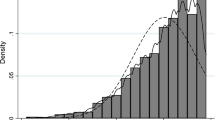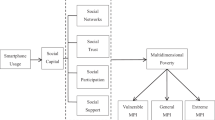Abstract
Due to the popularization of the Internet in rural China, mobile Internet use has become an essential part of rural residents’ lives and work. No studies, however, have investigated the potential effect of smartphone use on quality of life among rural residents in China. This study thus applies ordinary least squared, conditional quantile and instrumental variable techniques to survey data for 493 rural Chinese households to assess the impact of smartphone use (SU) on their subjective well-being (SWB). The results reveal an association between SU and increases in both life satisfaction and happiness that remains even after we adjust for possible endogeneity. The analysis also indicates that SU intensity is associated with lower levels of both SWB measures, especially when it exceeds 3 h per day. Quantile estimates further indicate that in both participation and intensity, SU has a much greater impact on SWB at the median level of the SWB distribution. Our multiple mediation results show that the positive SU–SWB linkage is partially mediated by both farm income and off-farm income. This may suggest that the local government should invest in Internet infrastructure to promote agricultural activities and develop specific rural services to boost farm income via better access to information of agricultural production and market networks. Mobile information and communication technologies can also provide more opportunities for rural entrepreneurship and innovation, in particular by motivating young farmers to actively engage in rural e-business ventures which can raise off-farm income.



Similar content being viewed by others
Data availability
The datasets during and/or analysed during the current study are available from the corresponding author on reasonable request.
Notes
Horwood and Anglim [14] adopt Ryff’s six psychological well-being domains, including positive relations, autonomy, environmental mastery, personal growth, purpose of life and self-acceptance.
A detailed discussion of bias corrected (BC) and bias corrected and accelerated (BCa) confidence intervals is available in Efron [56].
As a robustness check, to capture possible differences in economic development and infrastructures across villages, we also introduced village-level dummies and the results (Table 10 in the Appendix) reveal that SU remains significantly associated with life satisfaction. For happiness, the coefficient is positive but insignificant.
A detailed discussion of related theories on the U-shape between age and SWB is available in Blanchflower and Oswald [34].
References
China Internet Network Information Center. (2019). The 43rd statistical report on Internet development in China. Beijing: China Internet Network Information Center.
Jing M. (2017). 89% of Chinese Internet users use smartphone to go online Beijing2017. Available from: http://usa.chinadaily.com.cn/business/2015-07/23/content_21390160.htm. Accessed 29 May 2019.
China Internet Network Information Center. (2015). The 36th statistical report on Internet development in China. Beijing: China Internet Network Information Center.
Rotondi, V., Stanca, L., & Tomasuolo, M. (2017). Connecting alone: Smartphone use, quality of social interactions and well-being. Journal of Economic Psychology, 63, 17–26.
Acker, J. C., & Mbiti, I. M. (2010). Mobile phones and economic development in Africa. Journal of Economic Perspectives, 24(3), 207–232.
Center, C. I. N. I. (2018). The 41st statistical report on Internet development in China. Beijing: China Internet Network Information Center.
Cao, C. (2018). Internet usage in rural communities on the rise Beijing: China daily. http://www.chinadaily.com.cn/a/201807/02/WS5b3992b0a3103349141e01d2.html. Accessed 29 May 2019.
Ma, W., Renwick, A., Nie, P., Tang, J., & Cai, R. (2018). Off-farm work, smartphone use and household income: Evidence from rural China. China Economic Review, 52, 80–94.
Ohly, S., & Latour, A. (2014). Work-related smartphone use and well-being in the evening. Journal of Personnel Psychology, 13(4), 174–183.
Gombert, L., Rivkin, W., & Kleinsorge, T. (2018). A diary-study on work-related smartphone use and employees’ well-being: The moderating role of basic need satisfaction. Zeitschrift für Arbeitswissenschaft, 72(2), 111–119.
Kim, Y.-J., Jang, H. M., Lee, Y., Lee, D., & Kim, D.-J. (2018). Effects of Internet and smartphone addictions on depression and anxiety based on propensity score matching analysis. International Journal of Environmental Research and Public Health, 15(5), 859.
Lee, K. E., Kim, S.-H., Ha, T.-Y., Yoo, Y.-M., Han, J.-J., Jung, J.-H., et al. (2016). Dependency on smartphone use and its association with anxiety in Korea. Public Health Reports, 131(3), 411–419.
Park, N., & Lee, H. (2012). Social implications of smartphone use: Korean college students’ smartphone use and psychological well-being. Cyberpsychology, Behavior, and Social Networking, 15(9), 491–497.
Horwood, S., & Anglim, J. (2019). Problematic smartphone usage and subjective and psychological well-being. Computers in Human Behavior, 97, 44–50.
Lee, Y.-K., Chang, C.-T., Lin, Y., & Cheng, Z.-H. (2014). The dark side of smartphone usage: Psychological traits, compulsive behavior and technostress. Computers in Human Behavior, 31, 373–383.
The World Factbook. (2013). Washington, DC: Central Intelligence Agency. https://www.cia.gov/library/publications/the-world-factbook/index.html. Accessed on 29 May 2019.
Elhai, J. D., Levine, J. C., Dvorak, R. D., & Hall, B. J. (2016). Fear of missing out, need for touch, anxiety and depression are related to problematic smartphone use. Computers in Human Behavior, 63, 509–516.
David, M. E., Roberts, J. A., & Christenson, B. (2018). Too much of a good thing: Investigating the association between actual smartphone use and individual well-being. International Journal of Human-Computer Interaction, 34(3), 265–275.
Hughes, N., & Burke, J. (2018). Sleeping with the frenemy: How restricting ‘bedroom use’ of smartphones impacts happiness and wellbeing. Computers in Human Behavior, 85, 236–244.
Kumcagiz, H., & Gündüz, Y. (2015). Relationship between psychological well-being and smartphone addiction of university students. International Journal of Higher Education, 5(4), 144–156.
Samaha, M., & Hawi, N. S. (2016). Relationships among smartphone addiction, stress, academic performance, and satisfaction with life. Computers in Human Behavior, 57, 321–325.
Elhai, J. D., Yang, H., Fang, J., Bai, X., & Hall, B. J. (2019). Depression and anxiety symptoms are related to problematic smartphone use severity in Chinese young adults: Fear of missing out as a mediator. Addictive Behaviors, 101, 105962.
Wang, J.-L., Wang, H.-Z., Gaskin, J., & Wang, L.-H. (2015). The role of stress and motivation in problematic smartphone use among college students. Computers in Human Behavior, 53, 181–188.
Yang, Z., Asbury, K., & Griffiths, M. D. (2019). An exploration of problematic smartphone use among Chinese university students: Associations with academic anxiety, academic procrastination, self-regulation and subjective wellbeing. International Journal of Mental Health and Addiction, 17(3), 596–614.
Inglehart, R. F. (2008). Changing values among Western publics from 1970 to 2006. West European Politics, 31(1–2), 130–146.
Diener, E., Diener, M., & Diener, C. (1995). Factors predicting the subjective well-being of nations. Journal of Personality and Social Psychology, 69, 851–864.
Steele, L. G., & Lynch, S. M. (2013). The pursuit of happiness in China: Individualism, collectivism, and subjective well-being during China’s economic and social transformation. Social Indicators Research, 114, 441–451.
Zhang, J., Yang, Y., & Wang, H. (2009). Measuring subjective well-being: A comparison of China and the USA. Asian Journal of Social Psychology, 12(3), 221–225.
Hübler, M., & Hartje, R. (2016). Are smartphones smart for economic development? Economics Letters, 141, 130–133.
Ma, W., Grafton, R. Q., & Renwick, A. (2018). Smartphone use and income growth in rural China: Empirical results and policy implications. Electronic Commerce Research. https://doi.org/10.1007/s10660-018-9323-x.
Preacher, K. J., & Hayes, A. F. (2008). Asymptotic and resampling strategies for assessing and comparing indirect effects in multiple mediator models. Behavior Research Methods, 40(3), 879–891.
Rucker, D. D., Preacher, K. J., Tormala, Z. L., & Petty, R. E. (2011). Mediation analysis in social psychology: Current practices and new recommendations. Social and Personality Psychology Compass, 5(6), 359–371.
Aker, J. C., & Ksoll, C. (2016). Can mobile phones improve agricultural outcomes? Evidence from a randomized experiment in Niger. Food Policy, 60, 44–51.
Fu, X., & Akter, S. (2016). The impact of mobile phone technology on agricultural extension services delivery: Evidence from India. The Journal of Development Studies, 52(11), 1561–1576.
Muto, M., & Yamano, T. (2009). The impact of mobile phone coverage expansion on market participation: Panel data evidence from Uganda. World Development, 37(12), 1887–1896.
Tadesse, G., & Bahiigwa, G. (2015). Mobile phones and farmers’ marketing decisions in Ethiopia. World Development, 68, 296–307.
Dammert, A. C., Galdo, J., & Galdo, V. (2013). Digital labor-market intermediation and job expectations: Evidence from a field experiment. Economics Letters, 120(1), 112–116.
Sekabira, H., & Qaim, M. (2017). Can mobile phones improve gender equality and nutrition? Panel data evidence from farm households in Uganda. Food Policy, 73, 95–103.
Munyegera, G. K., & Matsumoto, T. (2016). Mobile money, remittances, and household welfare: Panel evidence from rural Uganda. World Development, 79, 127–137.
Knight, J., Song, L., & Gunatilaka, R. (2009). Subjective well-being and its determinants in rural China. China Economic Review, 20(4), 635–649.
Otis, N. (2017). Subjective well-being in China: Associations with absolute, relative, and perceived economic circumstances. Social Indicators Research, 132(2), 885–905.
Kahneman, D., & Deaton, A. (2010). High income improves evaluation of life but not emotional well-being. Proceedings of the National Academy of Sciences, 107, 16489–16493.
Pénard, T., Poussing, N., & Suire, R. (2013). Does the Internet make people happier? Journal of Socio-Economics, 46, 105–116.
Ferrer-i-Carbonell, A., & Frijters, P. (2004). How important is the methodology for the estimates of determinants of happiness? The Economic Journal, 114(497), 641–659.
Blanchflower, D. G., & Oswald, A. J. (2008). Is well-being U-shaped over the life cycle? Social Science and Medicine, 66, 1733–1749.
Binder, M., & Coad, A. (2011). From average Joe’s happiness to miserable Jane and cheerful John: Using quantile regression to analyze the full subjective well-being distribution. Journal of Economic Behavior & Organization, 79(3), 275–290.
Diener, C., Lucas, R. E., & Scollon, C. N. (2006). Beyond the hedomic treadmill: Revising the adaptation theory of well-being. American Psychologist, 61(4), 305–314.
Cade, B. S., & Noon, B. R. (2003). A gentle introduction to quantile regression for ecologists. Frontiers in Ecology and the Environment, 1, 412–420.
Hao, L., & Naiman, D. Q. (2007). Quantile regression. London: Sage Publications.
Headey, B. (2014). Hedonic adaptation. In A. C. Michalos (Ed.), Encyclopedia of quality of life and well-being research (pp. 2831–2833). Dordrecht: Springer.
Terza, J. V., Basu, A., & Rathouz, P. J. (2008). Two-stage residual inclusion estimation: Addressing endogeneity in health econometric modeling. Journal of Health Economics, 27(3), 531–543.
MacKinnon, D. P., Fairchild, A. J., & Fritz, M. S. (2007). Mediation analysis. Annual Review of Psychology, 58, 593–614.
Kenny, D. A. (2008). Reflections on mediation. Organizational Research Methods, 11(2), 353–358.
Hilbrecht, M., Smale, B., & Mock, S. E. (2014). Highway to health? Commute time and well-being among Canadian adults. World Leisure Journal, 56(2), 151–163.
Nie, P., & Sousa-Poza, A. (2018). Commute time and subjective well-being in urban China. China Economic Review, 48, 188–204.
Efron, B. (1987). Better bootstrap confidence intervals. Journal of the American Statistical Association, 82(397), 171–185.
Lei, X., Shen, Y., Smith, J. P., & Zhou, G. (2015). Do social networks improve Chinese adults’ subjective well-being? The Journal of the Economics of Ageing, 6, 57–67.
Asadullah, M. N., Xiao, S., & Yeoh, E. (2018). Subjective well-being in China, 2005–2010: The role of relative income, gender, and location. China Economic Review, 48, 83–101.
Sarwar, M., & Soomro, T. R. (2013). Impact of smarphones on society. European Journal of Scientific Research, 98(2), 216–226.
Acknowledgements
Peng Nie would like to acknowledge the financial support provided by the National Natural Science Foundation of China (Grant No. 71804142) and the Start-Up Fund for Young Talent Support Plan (Grant No. 7121182501). Wanglin Ma gratefully acknowledges financial support from the Faculty of Agribusiness and Commerce at Lincoln University (Seed Fund Project INT 5056). We would like to thank the Editor, J. Christopher Westland and the Associate Editor, Seongmin Jeon and three anonymous referees for valuable comments on an earlier version of this paper.
Author information
Authors and Affiliations
Corresponding author
Ethics declarations
Conflict of interest
The authors declare that they have no conflict of interest.
Additional information
Publisher's Note
Springer Nature remains neutral with regard to jurisdictional claims in published maps and institutional affiliations.
Appendix
Rights and permissions
About this article
Cite this article
Nie, P., Ma, W. & Sousa-Poza, A. The relationship between smartphone use and subjective well-being in rural China. Electron Commer Res 21, 983–1009 (2021). https://doi.org/10.1007/s10660-020-09397-1
Published:
Issue Date:
DOI: https://doi.org/10.1007/s10660-020-09397-1




